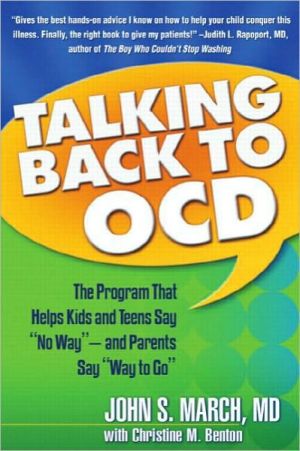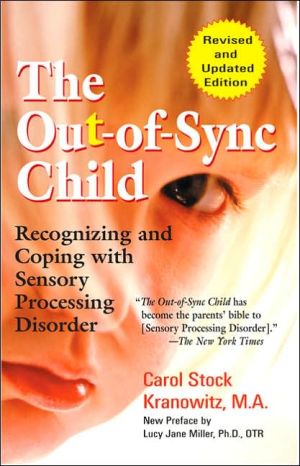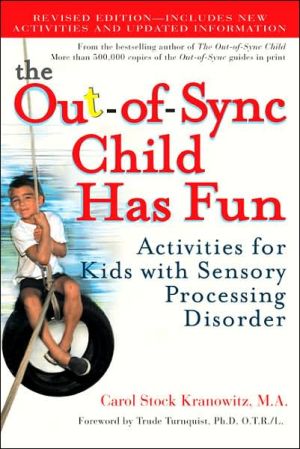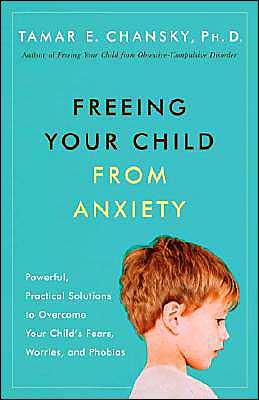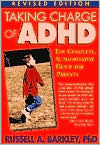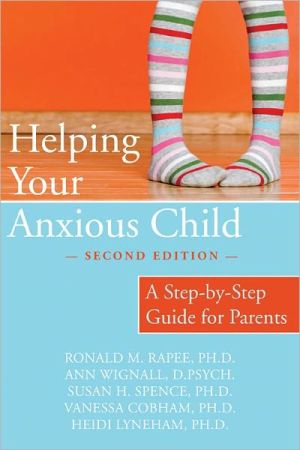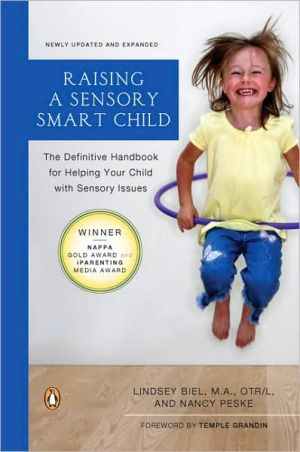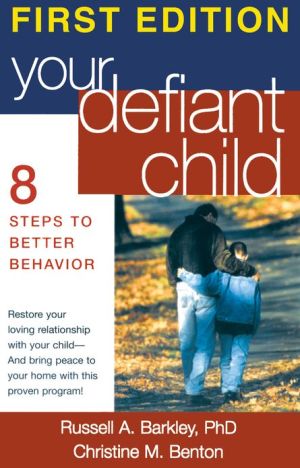Talking Back to OCD: The Program That Helps Kids and Teens Say No Way -- and Parents Say Way to Go
Fourteen-year-old Eric is plagued by thoughts that germs on his hands could be making his family sick. Kelly, age 8, feels distressed if she can't count her pencils in multiples of four. No one wants to get rid of OCD more than they do--that's why Talking Back to OCD puts the power to beat obsessions and compulsions in their hands. This uniquely designed volume is really two books in one. The first portion of each chapter teaches children and adolescents skills they can use to take charge of...
Search in google:
No one wants to get rid of obsessive-compulsive disorder more than someone who has it. That's why Talking Back to OCD puts kids and teens in charge. Dr. John March's eight-step program has already helped thousands of young people show the disorder that it doesn't call the shots--they do. This uniquely designed volume is really two books in one. Each chapter begins with a section that helps young readers zero in on specific problems and develop skills they can use to tune out obsessions and resist compulsions. Dr. March demonstrates how to: *Create a nickname for the illness to remember that OCD isn't you*Make a symptom chart so you can plan when and where to start talking back*Break the disorder's rules about the rituals The pages that follow the instructions for kids and teens show their parents how to be supportive without getting in the way, including tips for: *Separating the OCD from your son or daughter*Asking your child's permission to stop helping with rituals*Offering praise without imposing expectations After just a few months' practice, your family will get back to spending time on things that matter, instead of following pointless orders from the illness. The next time OCD butts in, you'll be prepared to boss back--and show an unwelcome visitor to the door. Library Journal According to March (chief of child & adolescent psychiatry, Duke Univ. Medical Ctr.), obsessive-compulsive disorder (OCD) can be fought with cognitive-behavioral therapy (CBT), which retrains the brain. This readable book, based on March's manual for therapists, OCD in Children and Adolescents, is for young people with OCD and their parents. In an encouraging tone, March explains that OCD is a "brain hiccup," and he provides neurological causes for the disorder. The majority of the book details a system of eight steps to follow within a time frame of three to five months. The first part of each step specifically addresses the child; the second part is aimed at the parent. Both parts include particular considerations for teenagers as well as tips on how a therapist can help. Worksheets, graphs, and quotes are scattered throughout; an appendix covers how to find a therapist, and additional resources are listed. There are other books on OCD for parents, such as Aureen Pinto Wagner's What To Do When Your Child Has Obsessive-Compulsive Disorder: Strategies and Solutions, but this is the only title aimed at both the sufferer and the parents; its emphasis on OCD as an illness motivates the child and parents to isolate OCD from the individual. Highly recommended.-Janet Clapp, Athens-Clarke Cty. Lib., GA Copyright 2007 Reed Business Information.
IntroductionI. Up Close But Not So Personal: A New Look at OCD for Parents (and Kids)1. What Is OCD?2. What Does OCD Look Like?3. What Causes OCD?4. How Is OCD Treated?II. Eight Steps for Getting Rid of Obsessions and Compulsions5. Step 1: What Kind of Treatment Is This, Anyway?Step 1: Instructions for Parents6. Step 2: Talking Back to OCDStep 2: Instructions for Parents7. Step 3: Making a MapStep 3: Instructions for Parents8. Step 4: Finishing My ToolkitStep 4: Instructions for Parents9. Step 5: Beginning to ResistStep 5: Instructions for Parents10. Step 6: I'm in Charge NowStep 6: Instructions for Parents11. Step 7: Eliminating OCD EverywhereStep 7: Instructions for Parents12. Step 8: Keeping OCD Away for GoodStep 8: Instructions for ParentsSummaries of the Steps How to Find a Therapist Resources Appendix: Scales, Checklists, and Other Forms
\ Library JournalAccording to March (chief of child & adolescent psychiatry, Duke Univ. Medical Ctr.), obsessive-compulsive disorder (OCD) can be fought with cognitive-behavioral therapy (CBT), which retrains the brain. This readable book, based on March's manual for therapists, OCD in Children and Adolescents, is for young people with OCD and their parents. In an encouraging tone, March explains that OCD is a "brain hiccup," and he provides neurological causes for the disorder. The majority of the book details a system of eight steps to follow within a time frame of three to five months. The first part of each step specifically addresses the child; the second part is aimed at the parent. Both parts include particular considerations for teenagers as well as tips on how a therapist can help. Worksheets, graphs, and quotes are scattered throughout; an appendix covers how to find a therapist, and additional resources are listed. There are other books on OCD for parents, such as Aureen Pinto Wagner's What To Do When Your Child Has Obsessive-Compulsive Disorder: Strategies and Solutions, but this is the only title aimed at both the sufferer and the parents; its emphasis on OCD as an illness motivates the child and parents to isolate OCD from the individual. Highly recommended.-Janet Clapp, Athens-Clarke Cty. Lib., GA Copyright 2007 Reed Business Information.\ \
